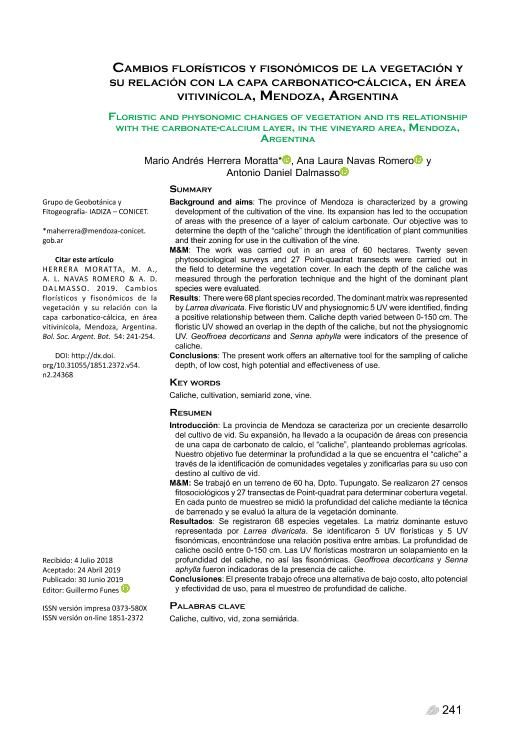Mostrar el registro sencillo del ítem
dc.contributor.author
Herrera Moratta, Mario Andres

dc.contributor.author
Navas Romero, Ana Laura

dc.contributor.author
Dalmasso, Antonio Daniel

dc.date.available
2022-01-25T13:15:52Z
dc.date.issued
2019-06
dc.identifier.citation
Herrera Moratta, Mario Andres; Navas Romero, Ana Laura; Dalmasso, Antonio Daniel; Cambios florísticos y fisonómicos de la vegetación y su relación con la capa carbonatico-cálcica, en área vitivinícola, Mendoza, Argentina; Sociedad Argentina de Botánica; Boletín de la Sociedad Argentina de Botánica; 54; 2; 6-2019; 241-254
dc.identifier.issn
0373-580X
dc.identifier.uri
http://hdl.handle.net/11336/150608
dc.description.abstract
Introducción: La provincia de Mendoza se caracteriza por un creciente desarrollo del cultivo de vid. Su expansión, ha llevado a la ocupación de áreas con presencia de una capa de carbonato de calcio, el “caliche”, planteando problemas agrícolas. Nuestro objetivo fue determinar la profundidad a la que se encuentra el “caliche” a través de la identificación de comunidades vegetales y zonificarlas para su uso con destino al cultivo de vid. M&M: Se trabajó en un terreno de 60 ha, Dpto. Tupungato. Se realizaron 27 censos fitosociológicos y 27 transectas de Point-quadrat para determinar cobertura vegetal. En cada punto de muestreo se midió la profundidad del caliche mediante la técnica de barrenado y se evaluó la altura de la vegetación dominante. Resultados: Se registraron 68 especies vegetales. La matriz dominante estuvo representada por Larrea divaricata. Se identificaron 5 UV florísticas y 5 UV fisonómicas, encontrándose una relación positiva entre ambas. La profundidad de caliche osciló entre 0-150 cm. Las UV florísticas mostraron un solapamiento en la profundidad del caliche, no así las fisonómicas. Geoffroea decorticans y Senna aphylla fueron indicadoras de la presencia de caliche. Conclusiones: El presente trabajo ofrece una alternativa de bajo costo, alto potencial y efectividad de uso, para el muestreo de profundidad de caliche.
dc.description.abstract
Background and aims: The province of Mendoza is characterized by a growing development of the cultivation of the vine. Its expansion has led to the occupation of areas with the presence of a layer of calcium carbonate. Our objective was to determine the depth of the “caliche” through the identification of plant communities and their zoning for use in the cultivation of the vine. M&M: The work was carried out in an area of 60 hectares. Twenty seven phytosociological surveys and 27 Point-quadrat transects were carried out in the field to determine the vegetation cover. In each the depth of the caliche was measured through the perforation technique and the hight of the dominant plant species were evaluated. Results: There were 68 plant species recorded. The dominant matrix was represented by Larrea divaricata. Five floristic UV and physiognomic 5 UV were identified, finding a positive relationship between them. Caliche depth varied between 0-150 cm. The floristic UV showed an overlap in the depth of the caliche, but not the physiognomic UV. Geoffroea decorticans and Senna aphylla were indicators of the presence of caliche. Conclusions: The present work offers an alternative tool for the sampling of caliche depth, of low cost, high potential and effectiveness of use.
dc.format
application/pdf
dc.language.iso
spa
dc.publisher
Sociedad Argentina de Botánica

dc.rights
info:eu-repo/semantics/openAccess
dc.rights.uri
https://creativecommons.org/licenses/by-nc-sa/2.5/ar/
dc.subject
CULTIVO
dc.subject
VID
dc.subject
CALICHE
dc.subject
ZONA SEMIÁRIDA
dc.subject.classification
Ciencias de las Plantas, Botánica

dc.subject.classification
Ciencias Biológicas

dc.subject.classification
CIENCIAS NATURALES Y EXACTAS

dc.title
Cambios florísticos y fisonómicos de la vegetación y su relación con la capa carbonatico-cálcica, en área vitivinícola, Mendoza, Argentina
dc.title
Floristic and physonomic changes of vegetation and its relationship with the carbonate-calcium layer, in the vineyard area, Mendoza, Argentina
dc.type
info:eu-repo/semantics/article
dc.type
info:ar-repo/semantics/artículo
dc.type
info:eu-repo/semantics/publishedVersion
dc.date.updated
2022-01-03T14:02:24Z
dc.identifier.eissn
1851-2372
dc.journal.volume
54
dc.journal.number
2
dc.journal.pagination
241-254
dc.journal.pais
Argentina

dc.journal.ciudad
Ciudad Autónoma de Buenos Aires
dc.description.fil
Fil: Herrera Moratta, Mario Andres. Consejo Nacional de Investigaciones Científicas y Técnicas. Centro Científico Tecnológico Conicet - Mendoza. Instituto Argentino de Investigaciones de las Zonas Áridas. Provincia de Mendoza. Instituto Argentino de Investigaciones de las Zonas Áridas. Universidad Nacional de Cuyo. Instituto Argentino de Investigaciones de las Zonas Áridas; Argentina
dc.description.fil
Fil: Navas Romero, Ana Laura. Consejo Nacional de Investigaciones Científicas y Técnicas. Centro Científico Tecnológico Conicet - Mendoza. Instituto Argentino de Investigaciones de las Zonas Áridas. Provincia de Mendoza. Instituto Argentino de Investigaciones de las Zonas Áridas. Universidad Nacional de Cuyo. Instituto Argentino de Investigaciones de las Zonas Áridas; Argentina
dc.description.fil
Fil: Dalmasso, Antonio Daniel. Consejo Nacional de Investigaciones Científicas y Técnicas. Centro Científico Tecnológico Conicet - Mendoza. Instituto Argentino de Investigaciones de las Zonas Áridas. Provincia de Mendoza. Instituto Argentino de Investigaciones de las Zonas Áridas. Universidad Nacional de Cuyo. Instituto Argentino de Investigaciones de las Zonas Áridas; Argentina
dc.journal.title
Boletín de la Sociedad Argentina de Botánica

dc.relation.alternativeid
info:eu-repo/semantics/altIdentifier/url/https://revistas.unc.edu.ar/index.php/BSAB/article/view/24368
dc.relation.alternativeid
info:eu-repo/semantics/altIdentifier/doi/https://doi.org/10.31055/1851.2372.v54.n2.24368
Archivos asociados
